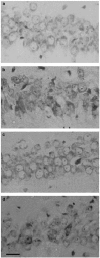Capsaicin exhibits neuroprotective effects in a model of transient global cerebral ischemia in Mongolian gerbils
- PMID: 15678080
- PMCID: PMC1576053
- DOI: 10.1038/sj.bjp.0706115
Capsaicin exhibits neuroprotective effects in a model of transient global cerebral ischemia in Mongolian gerbils
Abstract
1. Capsaicin, the irritant principle of hot peppers, is a vanilloid agonist known to activate the transient receptor potential channel vanilloid subfamily member 1 (VR1), recently reported to be involved in neurodegeneration. The present study investigated the role of VR1 in a model of global cerebral ischemia in gerbils. 2. Over the dose range tested, capsaicin (0.01, 0.025, 0.05, 0.2 and 0.6 mg kg(-1)), given 5 min after recirculation, dose-dependently antagonized the ischemia-induced electroencephalographic total spectral power decrease and restored relative frequency band distribution evaluated 7 days after ischemia. 3. Capsaicin, at all tested doses, fully prevented ischemia-induced hyperlocomotion evaluated 1 day after ischemia. 4. Capsaicin dose-dependently antagonized ischemia-induced memory impairment evaluated in a passive avoidance task, 3 days after ischemia. 5. Capsaicin showed a dose-dependent hypothermic effect evaluated for 2 h after recirculation. 6. At 7 days after ischemia, a progressive survival of pyramidal cells in the CA1 subfield in capsaicin-treated gerbils, with a maximum of 80%, at a dose of 0.2 mg kg(-1), was obtained. 7. The selective VR1 antagonist, capsazepine (0.01 mg kg(-1)), reversed capsaicin-induced protective effects, in a competitive manner. 8. These results suggest that the neuroprotective effect of capsaicin may be attributable, at least in part, to VR1 desensitization and provide a valuable target for development of interventional pharmacological strategies.
Figures






References
-
- ARAKI H., NOJIRI M., KAWASHIMA K., KIMURA M., AIHARA H. Behavioral, electroencephalographic and histopathological studies on mongolian gerbils with occluded common carotid arteries. Physiol. Behav. 1986;38:89–94. - PubMed
-
- BICKLER P.E., FAHLMAN C.S. Moderate increases in intracellular calcium activate neuroprotective signals in hippocampal neurons. Neuroscience. 2004;127:673–683. - PubMed
-
- BRAIDA D., PEGORINI S., ARCIDIACONO M.V., CONSALEZ G.G., CROCI L., SALA M. Post-ischemic treatment with cannabidiol prevents electroencephalographic flattening, hyperlocomotion and neuronal injury in gerbils. Neurosci. Lett. 2003;346:61–64. - PubMed
-
- BRAIDA D., POZZI M., SALA M. CP 55,940 protects against ischemia-induced electroencephalographic flattening and hyperlocomotion in Mongolian gerbils. Neurosci. Lett. 2000;296:183–191. - PubMed
-
- BROOKS J.W., PRYCE G., BISOGNO T., JAGGAR S.I., HANKEY D.J., BROWN P., BRIDGES D., LEDENT C., BIFULCO M., RICE A.S., DI MARZO V., BAKER D. Arvanil-induced inhibition of spasticity and persistent pain: evidence for therapeutic sites of action different from the vanilloid VR1 receptor and cannabinoid CB(1)/CB(2) receptors. Eur. J. Pharmacol. 2002;439:83–92. - PubMed
Publication types
MeSH terms
Substances
LinkOut - more resources
Full Text Sources
Other Literature Sources
Medical
Miscellaneous

